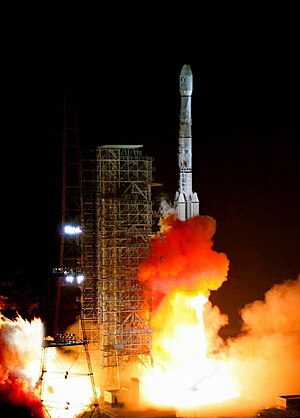Xichang Satellite Launch Center
The Xichang Satellite Launch Center (XSLC), also known as the Xichang Space Center, is a spaceport in China.
It is located in Zeyuan Town (泽远镇), approximately 64 kilometers (40 mi) northwest of Xichang, Liangshan Yi Autonomous Prefecture in Sichuan.
 The launch of Long March 3B Rocket, Xichang Satellite Launch Center, China. | |||||||||||||||||||||||||
| Location | Xichang, Liangshan, Sichuan | ||||||||||||||||||||||||
|---|---|---|---|---|---|---|---|---|---|---|---|---|---|---|---|---|---|---|---|---|---|---|---|---|---|
| Coordinates | 28°14′45.66″N 102°1′35.60″E / 28.2460167°N 102.0265556°E | ||||||||||||||||||||||||
| Short name | XSLC | ||||||||||||||||||||||||
| Operator | CASC | ||||||||||||||||||||||||
| Total launches | 204 | ||||||||||||||||||||||||
| Launch pad(s) | Two | ||||||||||||||||||||||||
| |||||||||||||||||||||||||
| Xichang Satellite Launch Center | |||||||
|---|---|---|---|---|---|---|---|
| Simplified Chinese | 西昌卫星发射中心 | ||||||
| Traditional Chinese | 西昌衛星發射中心 | ||||||
| |||||||
The facility became operational in 1984 and is used to launch numerous civil, scientific, and military payloads annually. It is notable as the site of Sino-European space cooperation, with the launch of the first of two Double Star scientific satellites in December 2003. Chinese officials have indicated interest in conducting additional international satellite launches from XSLC.
In 1996, a fatal accident occurred when the rocket carrying the Intelsat 708 satellite failed on launch from the Xichang Satellite Launch Center, killing at least 6 people in a nearby village. Uncontrolled debris from launches continues to fall in the vicinity, most recently in December 2023.
A 2007 test of an anti-satellite missile was launched from the center.
History
China's first crewed space program
In order to support the Chinese Project 714 crewed space program in the 1960s, the construction of a new space center at Xichang in the Sichuan province was decided, located farther from the Soviet border, thus safer. This construction was part of the Third Front campaign to develop basic industry and national security industry in the rugged interior of China to prepare for potential United States or Soviet Union invasion.
The Shuguang One spacecraft was expected to be launched from the launch pad number one. After the cancellation of the program, the launch pad was never completed. Today, a viewing platform for officials has been built at the site.
First Long March-2E carrier rocket
China launched its first Long March-2E carrier rocket on 16 July 1990, sending into orbit Pakistan's first indigenously developed Badr-1 satellite and HS-601.
1996 Launch accident
On 15 February 1996, a fatal accident occurred when the first new Long March 3B heavy carrier rocket carrying Intelsat 708 veered off course 22 seconds after launch, crashing 1200 meters away from the launch pad in a nearby mountain village, destroying 80 homes. According to the official report, six people died and 56 were injured. The number of civilian deaths has been disputed, with estimates of the number of casualties as around a few hundred.
China's first successful ASAT test
On 11 January 2007, China conducted an anti-satellite missile test with an SC-19 ASAT weapon.
A Chinese weather satellite — the FY-1C polar orbit satellite of the Fengyun series, at an altitude of 865 kilometers (537 mi), with a mass of 750 kg — was destroyed by a kinetic kill vehicle.
The SC-19 has been described as being based on a modified DF-21 ballistic missile or its commercial derivative, the KT-2 with a Kinetic Kill Vehicle and is fully mobile.
Beginning of China's lunar exploration program
On October 24, 2007, Chang'e 1, an un-crewed Moon orbiter of the Chang'e program, was successfully launched from the facility, marking the beginning of China's lunar exploration program.
First Long March-3C carrier rocket
China launched its first Long March-3C carrier rocket on April 25, 2008. This was the 105th mission of China's Long March series of rockets, and also the launch of the nation's first data relay satellite (数据中继卫星) Tianlian I (天链一号).
A new launch pad for next-generation rockets (such as Long March 8) is currently under construction, as of December 2019.
Facilities


Launch Complexes
Three launch complexes were planned, and two were built:
Launch Complex 1 (LC-1), not built, was intended as the Shuguang launch site, later used as a viewing area.
Launch Complex 2 (LC-2 or LA-2), located at 28°14′44″N 102°01′36″E / 28.24550°N 102.02678°E, and used for launching Long March 2E, Long March 3A, Long March 3B and Long March 3C rockets.
Launch Complex 3 (LC-3 or LA-3), also known as LA-1, and located at 28°14′50″N 102°01′45″E / 28.2471400°N 102.0291100°E. Used for launching Long March 2C, Long March 3, Long March 3A and Long March 3B rockets. Demolished and rebuilt between 2005 and 2006. Upgraded in order to support the Chinese Lunar Exploration Program. Demolished and rebuilt again between 2013 and 2015.[failed verification]
Technical Center

XSLC's Technical Center is equipped for testing and integration of the payload and launch vehicle. Its Mission Command and Control Center is located 7 kilometers (4.3 mi) southwest of the launch pads, and provides flight and safety control during overall system rehearsal and launch. It is serviced by a dedicated railway and highway directly from Xichang Qingshan Airport and Manshuiwan railway station, which is about 50 kilometers (31 mi) away from the launch site. Two launch complexes at the facility support flight operations.
See also
Notes
References
External links
- Aerial Maps from Google Maps
This article uses material from the Wikipedia English article Xichang Satellite Launch Center, which is released under the Creative Commons Attribution-ShareAlike 3.0 license ("CC BY-SA 3.0"); additional terms may apply (view authors). Content is available under CC BY-SA 4.0 unless otherwise noted. Images, videos and audio are available under their respective licenses.
®Wikipedia is a registered trademark of the Wiki Foundation, Inc. Wiki English (DUHOCTRUNGQUOC.VN) is an independent company and has no affiliation with Wiki Foundation.